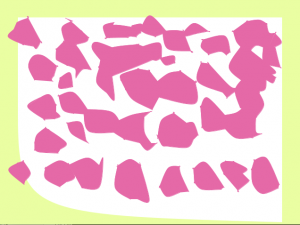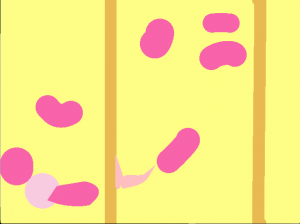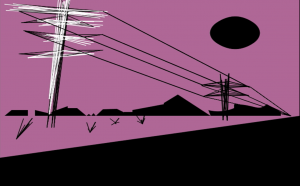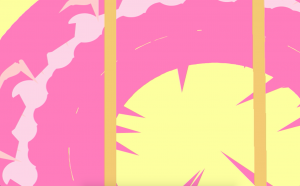I attempted to make hard-coded and animated recreations of Hirsh’s style from Scratch Pad using processing and although some do not fully capture the expressive experimental style of his film I am content with the results.
The project first began to change from my initial intentions when I had to understand the limits of the softwares ability to create functions that would sometimes contradict each other in order to create the same patterns as Hirsh. This was particularly the case when I first began hardcoding his patterns and when I had to animate them the coordinates of the designs would chaotically sprout of control. I had this problem with sketch 1, which is a screenshot of a hardcoded image, and in the film that pattern rotates across the screen but when I tried this in processing the entire image was rotated into a sporadic mixture of shapes. 
Even though this code did not turn out how I expected it to, I think it captures the same intent of Hirsh’s pattern by creating a pattern that is unrestrained by the intents of the artist, given itself its own sense of autonomy.
However, what went right with the project is that using noise was an effective method to capture the same effects of Hirsh’s patterns as well as the fine details of his film. I thought noise was particularly useful in image number 2 where I used “for” to create a series of black dots to apply the same kind of graininess as in the original footage, as well as to create a contrasting static effect with the stillness of the background. For image number 3 I used “laststep” in order to create a singular generative pattern of lines and implemented the “random” function to their coordinates.
When I first began on these sketches I momentarily struggled with creating shapes made to look like they were drawn with expression of a human or chemical reaction rather than the pinpoint accuracy of a computer. However once I properly understood the system of vertex shapes and their relationship with “bezierVertex” commands the process became much more fluid. I also found “curveVertex” shapes to become progressively easier the more specific I was with the shapes and fill I desired. This was particularly the case with image number 4 where I incorporated a portrait photograph of myself and outlined certain areas of my face to add expression and add random to fill my shadow in order to change its form.
Overall I think the sketches are aesthetically appealing but I also think they need to be more fine tuned and include more functions in order to show more signs of progressions in the forms displayed.
For image no.3 I changed the coordinates of the black foreground into a diagonal line in order to change the picture plane so that it wouldn’t appear as flat as before. I then drew subtle lines using noise to appear as plants being blown by wind and then created a black sun using noise lines. I then created a second telephone pole and connected it to the first white telephone pole with electrical lines . I called the movie ‘Desert Highway’ because I think the overall image looks like a desert landscape and that there is an uncanny resemblance the figures and shapes in the film have to natural or industrial structures in real life.
For image no.2 I added a noise background with texture just like in the film and added noise to all sides of the yellow square so that there is a constant flow of movement with all the patterns in the sketch. I called this sketch ‘Static because I thought the noise patterns are quite intense like the electric static on an old fashioned television.
For image no.1 I used ‘push matrix’ and ‘pull matrix’ in order to make individual shapes rotate independently of each other. The shapes now rotate in a complete circle and also as a result create interesting patterns that continue to develop as the shapes continuously rotate.
I created another sketch from Hirsh’s film where a series of randomly drawn dots fill up the screen:
In order to create every uniquely shaped dot I used ‘curveVertex’ which resulted in the shapes in the recreation being almost identical to the original footage:
I then made the sketch interactive by implementing ‘mouseX’ and ‘mouseY’ into the shapes coordinates along with noise too so that the shapes could be constantly moving and changing even when the mouse is stationary.









